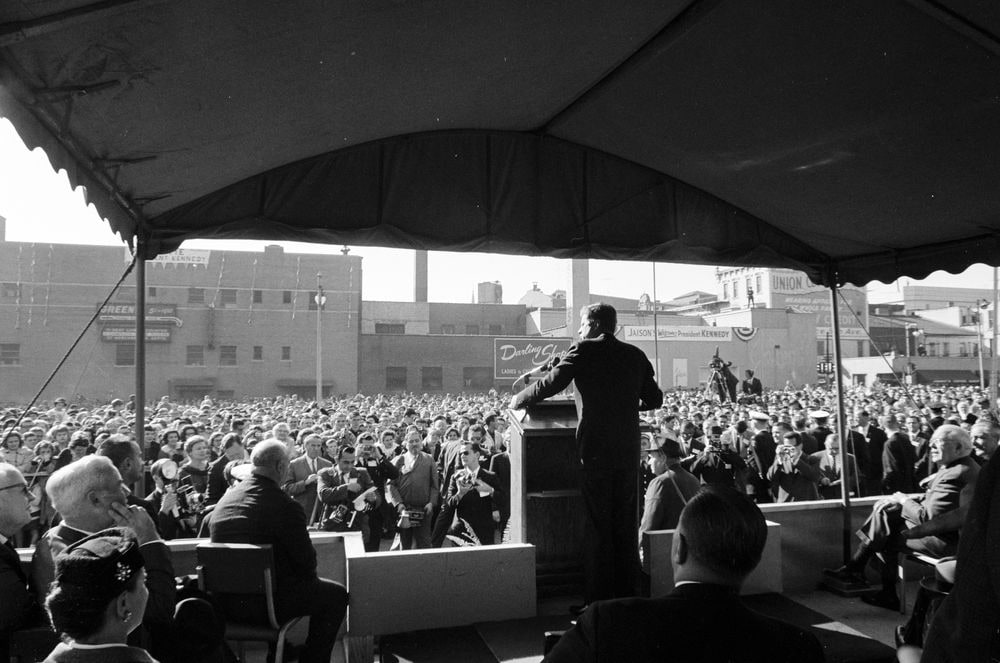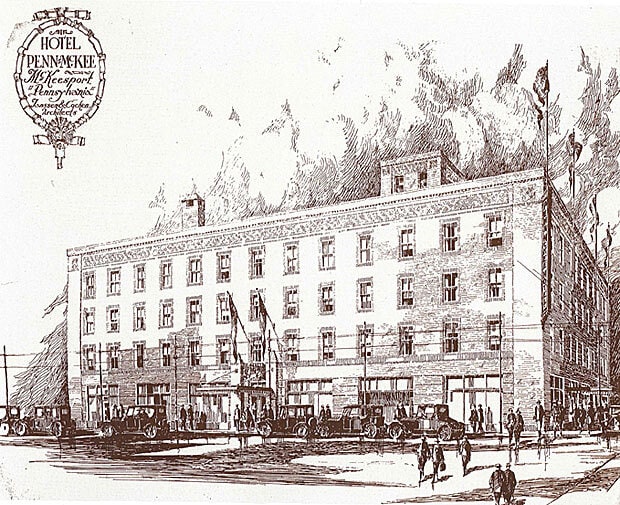“If it happens in McKeesport, it happens at the Penn–McKee.”
That was the proud booster slogan heard throughout the Mon Valley for 40-plus years following the 1926 opening of the elegant Penn-McKee Hotel in the heart of downtown McKeesport.

Kennedy & Nixon at the Penn McKee
It was never more true than on Tuesday evening, April 22, 1947, when a hundred or so members of a local public affairs group gathered in the hotel ballroom to witness a lively debate between two young politicians seeking a bigger piece of the national limelight — John F. Kennedy of Massachusetts and Richard M. Nixon of California.
Kennedy, 30, and Nixon, 34, had just been elected to their first term in the U.S. House of Representatives, and both served on the House’s Labor and Education Committee. Their topic was the expected impact of the Taft-Hartley Labor Management Relations Act up for a vote in Congress that spring. Republicans supported the legislation for its union-restricting provisions, while Democrats saw the bill as excessively weighted against workers.
The 90-minute debate was not recorded, but the next day’s newspaper reporting summarized the speakers’ styles. Nixon went on the attack, visibly antagonizing labor supporters in the audience. Kennedy presented a contrasting calmness, clearly attempting to win over business leaders. After a quick post-debate snack at the nearby Star Diner, Kennedy and Nixon ended up sharing a train compartment back to Washington, D.C. and, as Nixon recalled in his memoirs, talking well into the night about world events and the new baseball season.
Holding the debate in McKeesport was an intentional choice for both parties, says Dr. Charles McCollester, retired labor history professor at the Indiana University of Pennsylvania. “It was the heart of an area where more than 100,000 unionized industrial workers were employed and central to the emerging post-World War II economy.”
Employees of McKeesport’s National Tube Works, were the leading producers of iron pipe in the world, adds David R. Stokes, author of Jack & Dick: When Kennedy Met Nixon. “McKeesport was the perfect setting for two ambitious men to have an animated conversation about the vital issues of the day.”
And the Penn-McKee was the perfect setting to hear that conversation between two future presidents of the United States.
The place to be
Built at the peak of a vigorous intra-county commercial rivalry between Pittsburgh and McKeesport, the Penn-McKee was designed by renowned architect Benno Janssen at the behest of McKeesport civic leaders desiring a hotel that would surpass the splendor of any lodging Pittsburgh might offer.
Janssen, who had already designed the William Penn Hotel, Mellon Institute, 40th Street Bridge, University of Pittsburgh’s Alumni Hall and several commissions from department store magnate Edgar J. Kaufman, did not disappoint.
The Penn-McKee stretched an entire block along 5th Avenue and boasted 98 modern rooms, a coffee shop, lunchroom and cocktail lounge, and a glass-ceilinged, crystal-chandeliered, 700-seat ballroom featuring a 60-by-75-foot parquet dance floor built to accommodate 250 couples.
Gala opening ceremonies on Sept. 2, 1926, attracted a bevy of political and corporate dignitaries mingling to the high-society sounds of Danny Nirella & His Orchestra (who’d played at the 1909 opening of Forbes Field).
As the McKeesport Daily News proclaimed, the hotel was “a place to which one may take friends with more than ordinary pride.”
The future of the Penn-McKee hotel building
Over the next four decades, the Penn-McKee was McKeesport’s civic and social center, hosting a bustling schedule of community events, celebrity stays and innumerable campaign stops for candidates seeking state and national office.
By the 1970s, however, the hotel had changed owners and fallen on hard times, transitioning to a boarding house for the poor and elderly in the 1980s before becoming a vacant and gutted property in the 1990s.
Yet no matter what its clientele or state of repair, for nearly a century the hotel has stood as a striking barometer of McKeesport’s economic ups and downs. Today, local officials believe it can serve as the anchor for a range of new housing and business initiatives to revitalize downtown.
Last December, the city was awarded a six-year, $3 million grant through Pennsylvania’s Neighborhood Assistance Program, a state fund aiding private sector investment in urban redevelopment projects.
In addition to repairing blighted properties and dozens of owner-occupied homes around town, the grant prioritizes the rebuilding of the Penn-McKee as part of a tourism-driven recreation/entertainment complex incorporating the city marina, Palisades Event Center and Great Allegheny Passage — a 150-mile biking-hiking trail that runs through downtown McKeesport bringing close to 110,000 riders a year looking for places to eat, shop and spend the night.
A 2019 marketing and financial study by Young Preservationists Association of Pittsburgh laid out an ambitious plan to recast the Penn-McKee as a boutique hotel with a themed restaurant and/or brewhouse, bakery, coffee shop, ice cream shop, outdoor clothing store and other amenities.
Estimated cost for the reborn, rebranded Penn McKee: $12.8 million including restaurant and retail.
Last month, McKeesport Mayor Michael Cherepko hosted a delegation from three federal agencies (Department of Housing and Urban Development, Environmental Protection Agency and Department of Agriculture) advising on funding possibilities to speed the redevelopment process along. And the city and Young Preservationists have applied for an EPA grant to help remediate any environmental hazards.
Of course, you say, all this hotel history and future visioning are great …. but what you really want to know, is the Penn-McKee site haunted?
To date, no definitive paranormal evidence has been documented, and the hotel hasn’t landed on any Most Haunted Pennsylvania lists.
One thing is for sure: the spirit of the 1947 Kennedy-Nixon debate still permeates our current political loyalties, in Western Pennsylvania and across the U.S.
And who can say that a resurrected Penn-McKee 2.0 might not again play host to a president, or two.
Header Photo courtesy of Tube City Almanac







